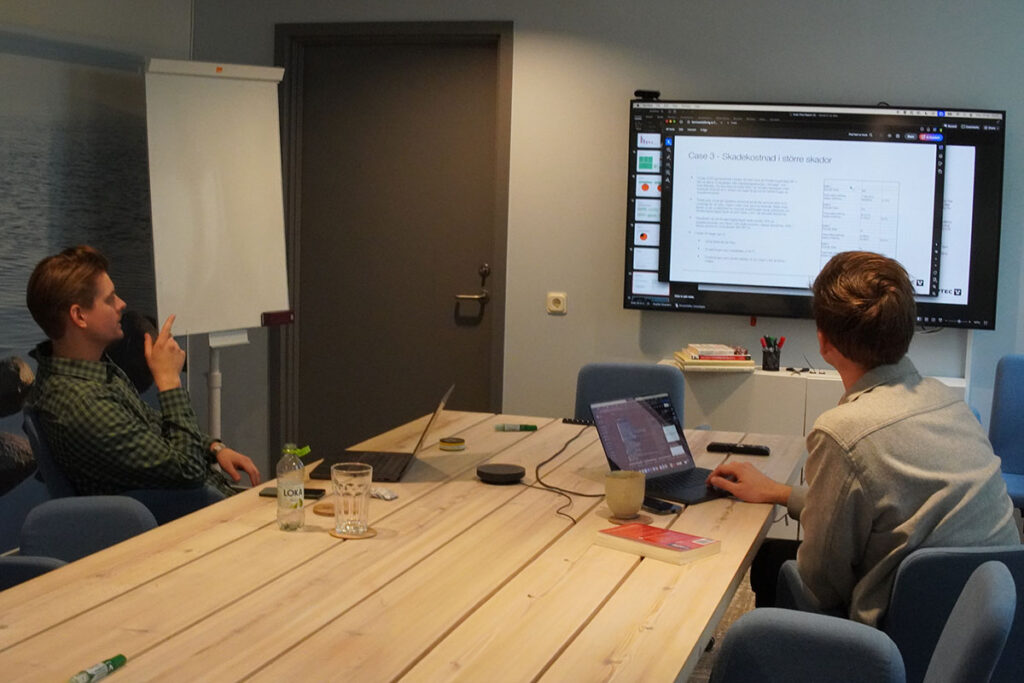Cut weeks from your claims timeline while boosting customer satisfaction
Every day a claim stays open costs you money, frustrates your customers, and gives competitors a chance to steal your business. The insurance companies winning today aren’t just faster, they’ve fundamentally reimagined how claims work.
The Real Cost of Slow Claims
When claims drag on, the damage goes far beyond annoyed customers calling for updates. You’re looking at:
When claims drag on, you’re not just dealing with inefficiency, you’re creating business risk:
Time Lost on Low-Value Work: Handlers spend hours chasing product specs, searching for pricing, and waiting on approvals, instead of resolving claims.
Customers Quietly Leave: Policyholders expect fast, transparent service. If they don’t get it, they start shopping before the claim is even closed.
Audit Risk Increases: Manual processes create gaps, inconsistent valuations, and poor documentation, opening the door to regulatory trouble.
Fragile in a Crisis: When volumes spike, old processes break. Peaks turn into backlogs, SLAs slip, and emergency staffing becomes the norm.
The companies still handling claims the old way aren’t just inefficient, they’re strategically vulnerable.

Cut weeks
from your claims timeline while boosting customer satisfaction
What Happens When You Automate Content Claims
One carrier cut weeks off their claims process and saw measurable results in just a few months:
- 74% reduction in handling time per claim
- 27% increase in direct settlements without manual review
- 31% jump in customer satisfaction scores
- 34% more claims resolved within three business days
These numbers represent millions in cost savings and customer retention that compounds year over year. That’s not just efficiency, it’s retention, reputation, and long-term growth.
So how do you get from manual chaos to a modern, fast-moving claims process? Here’s a practical checklist based on our experience with multiple insurers.
How to Get Started – Fast
A structured checklist for launching automation that actually works
1. Set Clear Goals & Involve the Right People
Why it matters: Clear goals align your team around outcomes, not just activities and keep the project focused on measurable business value.
Start by defining what success looks like for your claims organization. Good goals are measurable, realistic, and tied to existing pain points. Then, build a small, cross-functional team that can represent claims, operations, IT, and customer experience.
🎯 How to Set Good Goals:
- Make them measurable (tie them to KPIs you already track)
→ So you can prove ROI and track real impact over time. - Focus on specific problems (like time delays, inconsistent valuations, low NPS, high rework)
→ So the project solves meaningful pain points, not just generic improvement. - Keep them realistic for the first rollout (aim for value within 8–12 weeks)
→ So you create early momentum and avoid scope creep or stalled initiatives.
Example Goals:
- Reduce average content claim cycle time by 30% in 3 months
- Improve first-touch resolution rate from 55% to 75%
- Free up 1 hour per handler per day
- Reduce escalated claims by 20%
- Deliver proactive claim status updates without phone calls
| Role | Responsibility |
|---|---|
| Claims Manager | Owns the business case and success KPIs. Defines scope, goals, and key use cases. |
| Process Develope | Maps current workflows, identifies bottlenecks, and helps redesign processes for automation. |
| IT / Integration Lead | Manages system integration, data flow, and technical validation (including APIs, security, etc). |
| Change / Transformation Lead | Drives adoption, communication, and training. Acts as internal champion. |
| Customer Experience (CX) or Service Rep | Ensures the customer journey is preserved or improved. Flags any UX misalignments. |
Pro Tip: Frame your first automation project as a “pilot with measurable impact.” It lowers internal resistance and helps you move faster.
2. Map Your Current Claims Process
Why it matters: You can’t improve what you can’t see. Mapping your current process reveals hidden delays, redundant steps, and manual pain points.
Identify steps from FNOL to payout
→ So you see how long the process really takes, from the customer’s point of view.
Track handoffs, rework, and time delays
→ So you find where claims stall and where staff time is wasted.
Pro Tip: Walk through a few real-life cases with your team and document each delay, it quickly reveals patterns you can’t see in process diagrams.

3. Prioritize Automation Targets
Why it matters: Trying to automate everything at once creates risk, delays, and scope creep. Focusing on high-impact, low-complexity areas builds momentum.
Focus on high-frequency, low-complexity tasks
→ So your solution makes a big difference without introducing risk.
Examples: manual valuations, item identification, follow-ups, internal approvals
→ These steps often create the biggest cumulative delays across claims.
Start small and expand once early wins are proven
→ So you build trust internally and scale based on results.
Choose a low-complexity segment to start (e.g. content claims under €5,000)
→ So your rollout is manageable and success can be shown quickly.Pro Tip: Don’t start with what’s most “visible”, start with what wastes the most time at scale. Even 2 minutes saved per claim adds up fast
4. Choose Smart, Scalable Tech
Why it matters: The right solution doesn’t just work today, it grows with you and integrates easily with your ecosystem. So you want technology that delivers quick wins and supports long-term scale.
API-first and easy to integrate
→ So you avoid long IT projects and connect quickly to your core systems.
Connected to product/pricing databases
→ So handlers don’t have to search manually or guess compensation values.
Ready to scale across claim types and regions
→ So you can expand after proving initial value, no rework required.
Built-in UX and compliance capabilities
→ So adoption is easier and regulatory requirements are met from day one.
Pro Tip: Use a sandbox to test integrations in parallel with rollout planning.

5. Monitor Outcomes
Why it matters: Measuring and monitoring results builds internal trust, justifies investment, and highlights what’s working and what’s not.
Track: average cycle time, CSAT/NPS, escalation rate, claims per handler
→ So you know what’s improving and what’s not.
Set a baseline before starting
→ So results are clearly attributed to automation, not seasonal trends.
Share improvements with stakeholders to drive buy-in
→ So others support your next rollout and advocate for expansion.
Pro Tip: Use your success metrics in internal storytelling. A before/after graph in one slide can do more than a 10-page report to get leadership excited.
6. Scale to Complex Claims
Why it matters: Complex claims often move the slowest, involving manual intake, third-party coordination, and unclear ownership. But they also represent the biggest opportunity to reduce cycle time.
Leverage your existing data on content and valuations
→ So you avoid reinventing compensation logic and ensure fair, consistent payouts even in large claims.
Involve restoration firms and external vendors early
→ So handovers don’t stall progress and responsibilities are clear from day one.
Set digital standards for all parties
→ So coordination happens digitally and everyone uses the same tools and platforms, not spreadsheets, or pen and paper.
Pro Tip: Speed in complex claims comes from coordination. Use automation to align internal teams and external partners and replace manual touchpoints with shared, digital workflows.

Common Pitfalls That Kill Automation Projects
❌ Skipping Claims Handler Involvement
If the people using the system daily aren’t involved early, adoption will suffer. Test, train, and listen, their feedback is where real improvement happens.
❌ Focusing Only on Internal Efficiency
If automation speeds you up but frustrates the customer, it’s a step backwards. Design with both claims teams and policyholders in mind.
❌ Over-Engineering Day One
Trying to build the perfect solution upfront delays launch and drains momentum. Start small, prove value, and scale with confidence.
❌ Launching Without Success Metrics
If you can’t prove what changed, you won’t earn support for what’s next. Define what good looks like and track it from day one.
The Takeaway
Reducing claims cycle time isn’t a nice-to-have anymore, it’s table stakes for staying competitive. Done right, automation doesn’t just make you faster. It makes you more accurate, more compliant, and more resilient when volume spikes.
Most importantly, it transforms claims from a moment of tension in the customer relationship into a moment of trust. That’s the kind of competitive advantage that builds lasting business value.
Ready to see what’s possible?
Book a strategy session and we’ll show you exactly how to cut days or weeks from your claims timeline. Most clients see measurable improvements within 6-8 weeks of implementation.

Talk to Sales
By submitting, you accept Upptec’s Privacy Policy and consent to contact.
